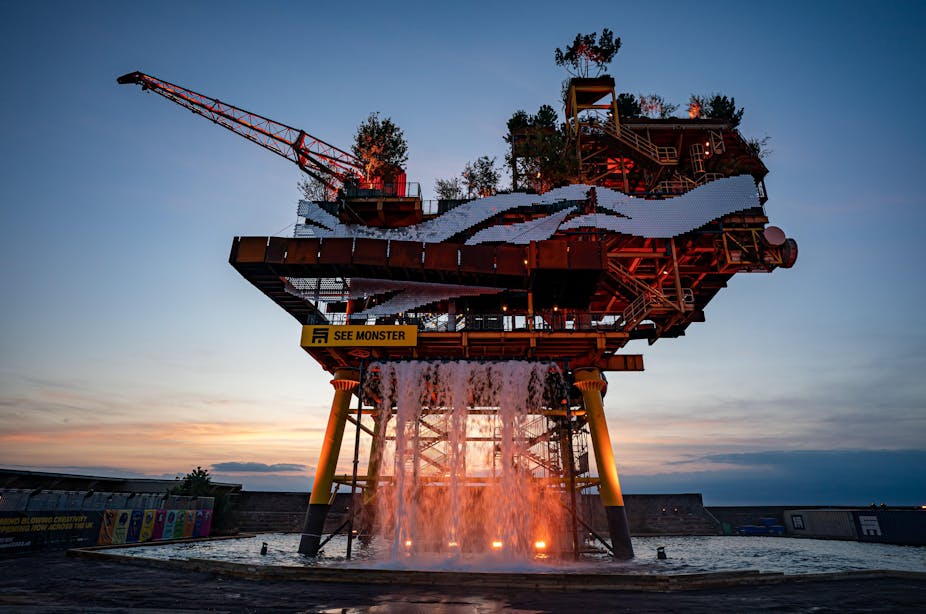Community, Leadership, Experimentation, Diversity, & Education
Pittsburgh Arts, Regional Theatre, New Work, Producing, Copyright, Labor Unions,
New Products, Coping Skills, J-O-Bs...
Theatre industry news, University & School of Drama Announcements, plus occasional course support for
Carnegie Mellon School of Drama Faculty, Staff, Students, and Alumni.
CMU School of Drama
Thursday, October 13, 2022
Weston-super-Mare’s See Monster: the good and the bad of pop-up attractions
theconversation.com: This autumn, visitors to Weston-super-Mare on the west coast of England will be confronted by the strangest of sights, a repurposed oil rig and temporary art installation and high-rise garden dubbed the “See Monster”.
Subscribe to:
Post Comments (Atom)

4 comments:
After just finishing my own art installation in Purnell I was excited to read about this art installation on the west coast of England. I find this art installation very intriguing as it is made from an old oil rig. The company Unboxed which helps to fund and allow these projects to happen works very hard at keeping the art installations up and ready for community use. The fact that this one has many different school groups and tourists come to visit it shows how attractive art installations can be to those outside of the everyday community. I am upset that this structure will only be up for 6 weeks and will not become a permanent attraction on the west coast of England. I believe that this exhibition should be permanent because it displays the climate change emergency perfectly and it created an ecosystem out of an oil rig, which is something that destroys ecosystems. Overall, I love this piece and wish I was able to see it before it is taken down.
This is a really cool piece of art. I think that the use of the decommissioned oil rig is a wonderful way of brining awareness to the climate crisis though a very obvious visual statement. And from the description of the piece I think that it sounds like a lot of fun to go to and experience. I can however also see the side of the story that argues that tearing it down so soon is a waste of resources and lends itself to a juxtaposition that is not so eco friendly. I would so much rather see a piece like this dis assembles and moved to a different area for a period of time. I think that this is a much more eco friendly way of keeping the message going, while also keeping in the popup nature of the piece. I have loved some of the traveling pop up art exhibits that have traveled through Pittsburgh and I think that the traveling lends itself as a solution to the argument against the pop up art. It keeps it interesting, relevant and in use so that it is not a "waste" of resources. Although I hardly ever think art is a waste.
I think this is a really cool way to repurpose an old oil rig. Of course, though, there are several caveats to this. For one, as mentioned in the article, this installation is a pop-up – it will only be around for a mere six weeks. For such a massive project, I think this is a remarkable short time period. On the other hand, I do appreciate the consideration for the local migrating wildlife. Another caveat is that there are simply far too many oil rigs in the world to make an installation piece out of all of them. It would also be a logistical nightmare to transport and convert all of them – The See Monster weighs in at a mere 450 tons. Granted, a lot of the machinery and other fluff has likely been removed, but the world’s largest oil rig weighs in at 200,000 tons. This makes the See Monster rig seem like nothing but a toy. In any case, I wish this were a permanent structure because I think it would be really cool to get a chance to visit and explore this repurposed rig.
This is a really interesting installation piece. The reason I clicked on this article was the thumbnail photo - the idea of a garden on an oil rig is so oxymoronic and interesting (as it was intended). I am a big fan of public art and art installations, and this one sends a very clear message about the climate and the crisis itself. Like the article suggests, I do find the fleeting nature of the installation to be a little bit ironic and counter-productive to its original message - although I do appreciate the consideration to the local wildlife. As the article discusses, pop-ups like this can be very controversial resource-wise - as although they are often beautiful and thought-provoking, they are expensive and don’t last particularly long - it’ll be interesting to see how the debate around these installations unfolds as the years progress and how the approach to making installation art changes. Although I will definitely not ever be able to visit, I think it’d be interesting to see this installation, the photos look beautiful.
Post a Comment